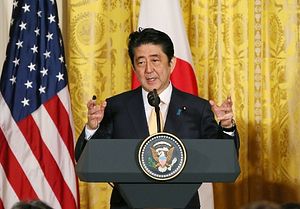On January 24, during the House of Representatives plenary session, Japanese Prime Minister Shinzo Abe urged opposition parties to amp up public debate toward a “broad based agreement” that would lead to amending Article 9 of the Japanese Constitution.
In his first key policy speech of the year, Abe said he hopes each political party will bring constructive proposals “to deepen discussion” to parliament so that “progress can move forward.” Abe’s rhetoric mostly centered around the need for careful nation building.
Abe explained in his speech it was “irresponsible” to ask Japan Self-Defense Force (SDF) personnel to put their lives on the line in an emergency while also toying with the idea their existence may be a “constitutional violation.” Abe emphasized it was the “responsibility of our generation” not to sweep the discussion under the rug.
The ruling Liberal Democratic Party (LDP) secretary general, Toshihiro Nikai, said rewriting the constitution is a matter of shaping the country and constituents ought to “fully consider” the question that a constitutional amendment poses.
Japan’s 71-year-old pacifist constitution has been interpreted by ruling governments to allow the SDF but not an army. But the SDF sits within a contentious gray zone edging closer to a broader interpretation of its military capabilities. Abe’s long awaited political goal of legitimizing Japan’s SDF depends on his proposal to add an additional clause to the constitution clarifying the SDF’s mission and purpose.
By the same token, in May last year, Abe’s LDP drafted another version of a constitutional revision also eliminating the clause in Article 9, Paragraph 2 that renounces war and the use of force. It’s this detail that’s responsible for currently keeping the SDF’s fighting potential in check. Fueling the extreme end of the debate are lawmakers like former LDP Secretary General Shigeru Ishiba, who stresses the “right to belligerence” — making “military aggression” an option for acts of defense, as opposed to warmongering.
Meanwhile, renewed debate has sparked friction from opposition parties including the Constitutional Democratic Party and Party of Hope. During the Diet session, the vice chair of the Japan Communist Party, Akira Koike, accused Abe of disregarding the voices of a large number of citizens who are “shifting toward suspicion and doubt with constitutional reform under Abe.” On the ground, citizen activism has reignited once more in Tokyo, with small groups and volunteers taking to the streets and train stations armed with megaphones protesting the threat of a remilitarized Japan.
Although Abe’s latest overall approval rating hovers at a safe 55 percent, that number doesn’t capture the whole constitutional political debate as opinion polls conducted by local media produce varying results depending on how questions are framed to participants.
For instance, in his policy speech, Abe harnessed favorable public opinion polls –suggesting over a 50 percent approval rating for a constitutional amendment and at least 60 percent who believe public debate should proceed — to justify a new move toward constitutional revision. On the other hand, a recent opinion poll by Nikkei Shimbun conducted over two days starting on January 26 suggested 47 percent of respondents favored preserving Paragraph 2 of Article 9, only approving an added clause giving clarity to the SDF, compared with 24 percent of constituents supporting the removal of the war-renouncing clause all together.
The first hurdle Abe faces in revising Japan’s constitution is securing a two-thirds majority in both the lower and upper house. Subsequently, he needs to get past a deeply divided public to earn a majority public vote through a national referendum. But rather than accelerating plans, Abe’s latest game plan is to break the ice by accommodating broad public consideration as a means to “deepen public understanding.” In turn, Abe has shed his original goal of achieving constitutional reform by 2020 and has not allocated a specified deadline, although a public vote is said to be aimed for this year.
While Abe pushes to add a clause to Article 9 to legitimize Japan’s SDF, interparty political tensions are looming, with LDP lawmakers split on whether or not to eliminate Paragraph 2 of Article 9. The LDP party’s position on a constitutional amendment plan will remain in dispute until a party convention to discuss constitutional policies to be held in late March.

































